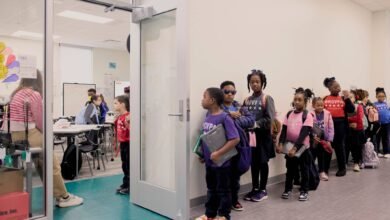
Experts say outreach and identifying the reasons keeping students out of the classroom is the best chance districts have of getting their students back.
Transcript:
A MARTÍNEZ, HOST:
One of the major issues this year in education has been the alarming number of students who have missed 15 days or more of school. Some states have seen chronic absenteeism soar to more than 40% of their students. Educators are sounding alarm bells, but parents, according to a new NPR/Ipsos poll, don’t see yet the urgency. NPR education reporter Sequoia Carrillo has the story.
SEQUOIA CARRILLO, BYLINE: When asked to define the term chronic absenteeism, only about 1 in 3 parents in our poll could pick the right definition. Cecelia Leong says she isn’t surprised.
CECELIA LEONG: It’s easy to hear the definition that chronic absence is missing 10% of the school year and not translate it into everyday reality.
CARRILLO: Leong is the vice president of programs at Attendance Works, a nonprofit that researches school attendance. She says absenteeism is sneaky. It creeps up on parents. A student only has to miss two days of school a month to end up chronically absent, so parents often don’t see it happening. In the years since 2020, the number has ballooned.
LEONG: We went from 8 million students to over 14.6 million chronically absent.
CARRILLO: Arizona, Alaska and Washington, D.C., have all seen absenteeism rates above 40% in recent years. The problem has aligned with historic drops in reading and math scores nationwide. Chronic absence has also long been a predictor of student dropout rates. Administrators are launching door-knocking or text campaigns in efforts to bring students back, but parents aren’t quite there yet, especially since the COVID shutdown.
MARITZA HERNANDEZ: Before the pandemic, like, the sniffles or his allergies or if he got sick, I’m like, he can still go to school. I gave him some Tylenol. He’s good.
CARRILLO: Maritza Hernandez lives in Phoenix with her three children. Two are still in school. One is 7, and the other is 18. Her youngest struggles with bad allergies during parts of the year.
HERNANDEZ: After the pandemic, I’m like, oh, no, I can’t send you to school ’cause you might get somebody else sick. I don’t know if this is just allergies, or it might be worse.
CARRILLO: She’s a single mom and says even when her kids are well, things just start to stack up in the morning.
HERNANDEZ: I’m guilty. I’m one of those parents that take my kids late mostly every day – every day – and sometimes, they’re marked absent.
CARRILLO: She calls the school or takes the time to go check them in at the office, but she’s normally waiting in a long line of parents to get a late pass, often making the kids even more tardy. Even when parents see absenteeism as a problem, they don’t always see it as their problem. According to the NPR/Ipsos poll, only 6% of parents surveyed identified their child as chronically absent, but the numbers nationwide show a disconnect.
THOMAS DEE: Prior to the pandemic, it was just under about 15% of students would meet the definition of chronic absenteeism, and that rate grew to nearly 30% in the 2021-22 school year.
CARRILLO: Thomas Dee is an education professor at Stanford University. He’s studied chronic absence after the pandemic and the resulting dip in test scores.
DEE: One very prominent explanation here that meets the evidence is that during the pandemic, many children and parents simply began to see less value in regular school attendance.
CARRILLO: Scholars call it norm erosion – essentially, students and parents fell out of the habit of school.
NICOLE WYGLENDOWSKI: What I’m not going to do here today is parent blame, right? They have a lot of other issues that they’re facing.
CARRILLO: Nicole Wyglendowski teaches elementary school in Philadelphia and knows that attendance is never a cut-and-dry issue.
WYGLENDOWSKI: My kids are missing school because we live in an area with bad air quality – right? – so their asthma acts up and they’re not sure if it’s their asthma or if it’s their allergies or if it’s COVID.
CARRILLO: She says that combined with things like housing insecurity, transportation issues, having little siblings who need to stay home and receive care, all result in more students staying home. Our poll asked parents about all kinds of issues facing K-12 education, and chronic absenteeism ranked last out of 12 topics, including bullying, gun violence, book bans and others. Only 5% of parents in the general population saw it as a top worry. Their highest priority? Preparing students for the future. Mallory Newall, a vice president at Ipsos, sees potential there.
MALLORY NEWALL: To prepare students adequately for the future, they need to be in the classroom. I think that could be a really effective and important linkage for parents that maybe parents in the public just aren’t making quite yet.
CARRILLO: Experts say outreach and identifying the reasons keeping students out of the classroom is the best chance districts have of getting their students back.
Sequoia Carrillo, NPR News.
Copyright 2024 NPR. To see more, visit https://www.npr.org.




